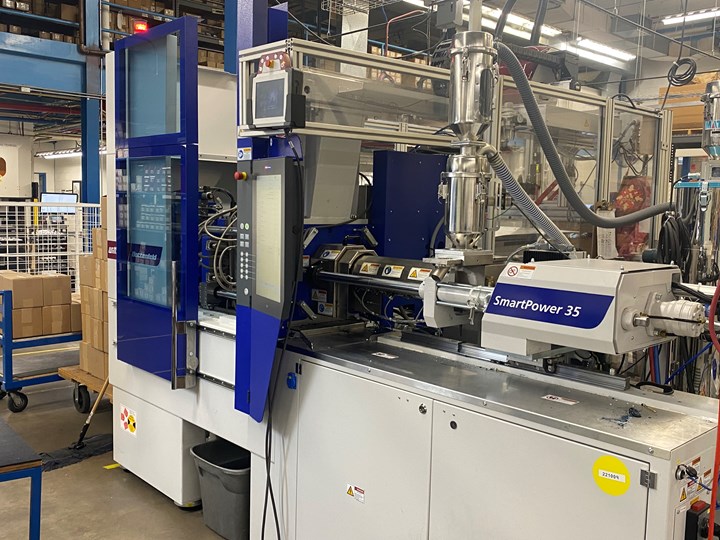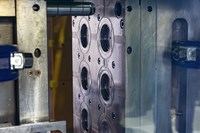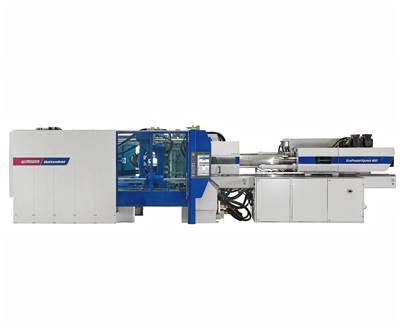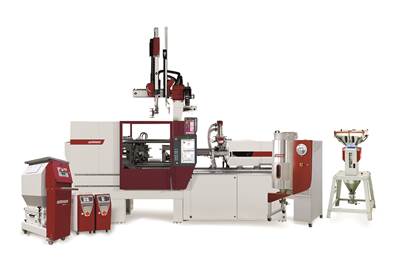Golf Equipment Manufacturer Scores Higher Productivity With Automated Cell
Ping was able to reduce labor and waste at its production facility in Phoenix via an automated molding cell courtesy of Wittmann.
In molding, as in golf, sometimes a lower number is the goal. Leading golf equipment maker Ping turned to Wittmann for a complete automated production cell that ultimately led to more and higher quality production of a decorative head-to-shaft transition component on Ping’s irons in a process that requires fewer total operators.
The all-new cell at Ping’s Phoenix, Arizona, production facility incorporates a Wittmann SmartPower 35/130 injection molding machine, a linear three-axis robot, a temperature control unit (TCU) and a granulator. Specified out by Wittmann, the cell also enabled Ping to shift from a four- to an eight-cavity mold. Ping, which has utilized Wittmann equipment going back to 1994,
runs seven Wittmann presses (ranging in size from 22 to 300 tons) out of nine total machines.
This latest automated cell has enabled Ping to double output with near lights-out production, eliminating a second work shift, explains Steve Jeffries, senior molding engineer at Ping. Now, one operator can run two presses at a time, where previously two to three operators were required to keep up with the press’s output, as parts were trimmed by hand. In the prior operation, runners were scrapped, now they’re reground and reincorporated. “The shot-to-shot repeatability is valuable in reducing defective parts,” Jeffries says. “We utilize 40% regrind and still get good shot-to-shot accuracy.”
For three decades now, Ping has relied on Wittmann to help automate higher volume jobs, when possible, Jeffries notes. Lower volume jobs can pose a challenge. “We have a lot of short-run operations, which can make automation challenging,” Jeffries says. “This also presents challenges with utilizing regrind and purchasing raw materials in economically priced quantities.”
Ping processes a diverse range of materials, ranging from polypropylene and ABS to nylons and more, with weighted parts requiring custom blends that can be hard on machinery. “We run a lot of heavily filled materials,” Jeffries says, “and this requires equipment with excellent wear properties.”
By reincorporating runners and other scrap, the company has significantly reduced its waste. “We’ve implemented this new program to address the significant amount of scrap we were generating,” Jeffries says, noting that the facility is now able to reclaim about 75% of what previously went straight to landfill.
In addition to optimizing the injection molding machine and work cell parameters, Wittmann also provided a training expert who dedicated nearly a week to working with Ping’s operators. “We really wanted a training expert here because we have early career maintenance technicians, and it’s hard to find technicians who know this type of equipment,” Jeffries says. “Even the maintenance is different, because now our service group has the ability to log into our computer and diagnose the equipment remotely, then have a technician perform the repair.”
Edgar Sanchez, Wittmann’s Western regional sales director for injection molding machines and automation, says Ping’s new automated production line “is a clear example of finding exactly the right fit for an automated molding cell — a situation in which a number of efficiencies can be realized the minute the switch is flipped.”
Jeffries says next on Ping’s wish list is possibly an additional work cell with a 120- to 200-ton press and another three-axis robot. Because the facility takes on a lot of hand-loaded, overmolded parts, Jeffries says it’s also considering purchasing a vertical press at some point.

A Wittmann SmartPower 35/130 injection molding machine is at the new heart of a production cell at Ping’s Phoenix facility that it uses to mold a decorative head-to-shaft transition component on the golf equipment maker’s irons. Source: Wittmann
Related Content
Paperless ‘Smart Factory’ Based on Automated Production Monitoring
Tier 1 automotive molder’s home-built production-monitoring and ERP systems, designed for “the little guy,” boost its efficiency rating and profits.
Read MorePursuing Paperless: Injection Molders Who Have Embraced Digitization
Read about injection molders who have shifted everything from quality control and scheduling to production and process monitoring to the digital realm.
Read MorePTXPO Recap: Smarter Resin Drying & Conveying Automation
Check out what you missed on the PTXPO show floor. In this video, Editorial Director Jim Callari breaks down how AI is changing the game in plastics manufacturing.
Read MoreWhat to Look for in High-Speed Automation for Pipette Production
Automation is a must-have for molders of pipettes. Make sure your supplier provides assurances of throughput and output, manpower utilization, floor space consumption and payback period.
Read MoreRead Next
Wittmann Battenfeld Shows Two New Machines in Work Cells for Medical, Packaging, and Automotive
The U.S. market is getting its first look at Wittmann Battenfeld’s high-speed, all-electric EcoPower Xpress for packaging, and its MicroPower two-shot micromolder.
Read MoreIMM Cells Display Communications, Energy Measurement and Energy Recovery
NPE2024: Wittmann is featuring five injection molding machines incorporating its range of robotics and auxiliaries, with all products employing industry 4.0 communications, energy measurement and a brand-new red color.
Read MoreMaking the Circular Economy a Reality
Driven by brand owner demands and new worldwide legislation, the entire supply chain is working toward the shift to circularity, with some evidence the circular economy has already begun.
Read More














